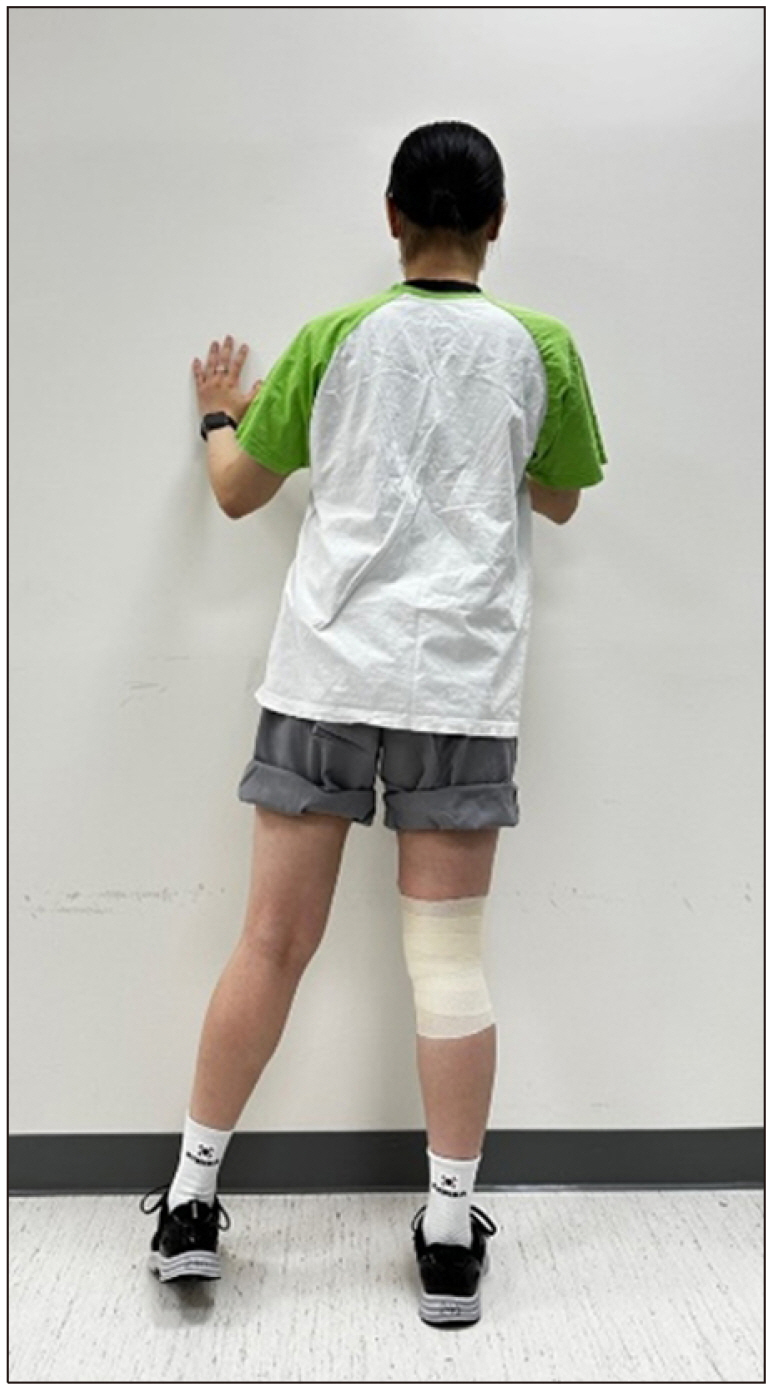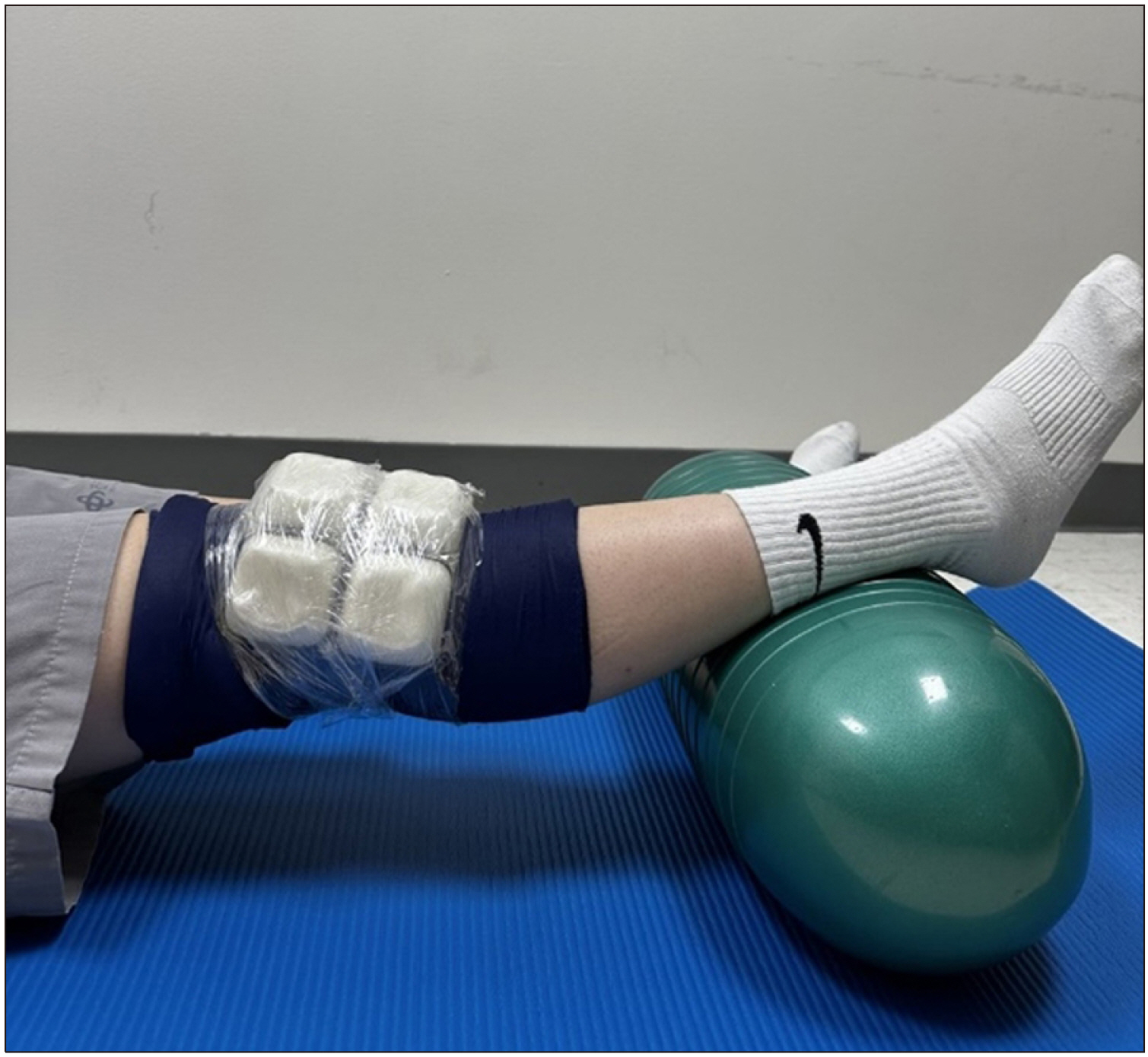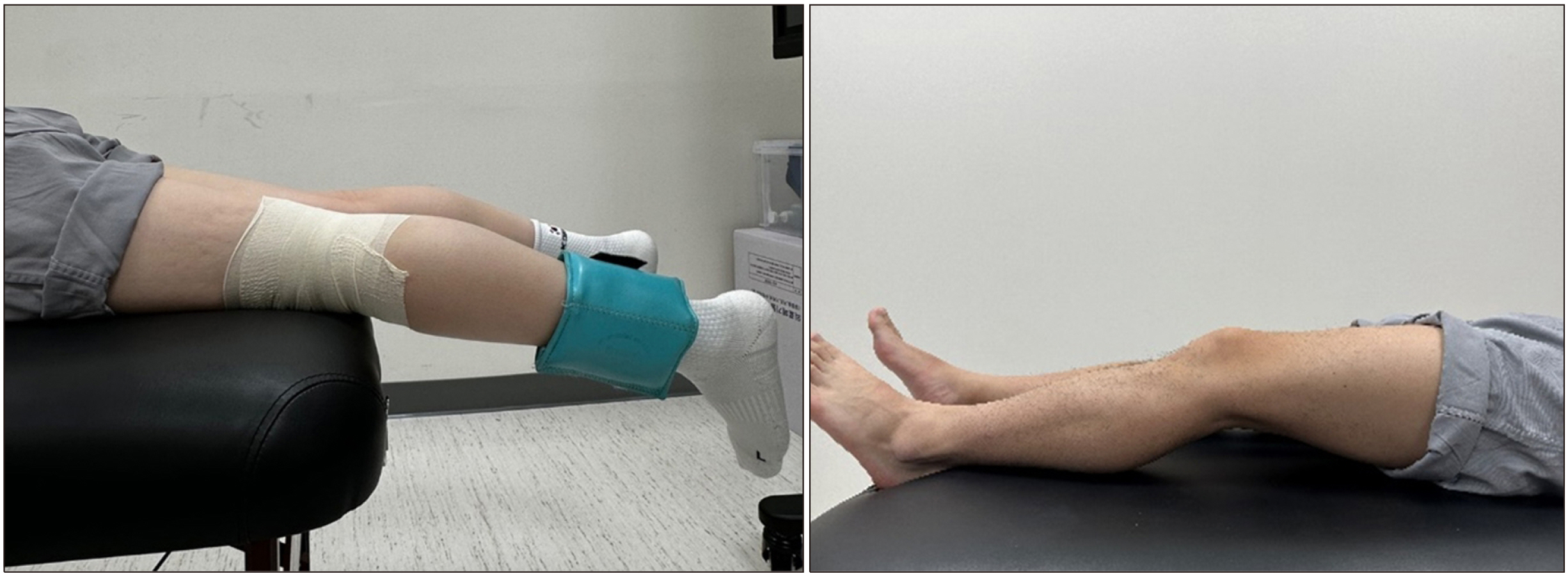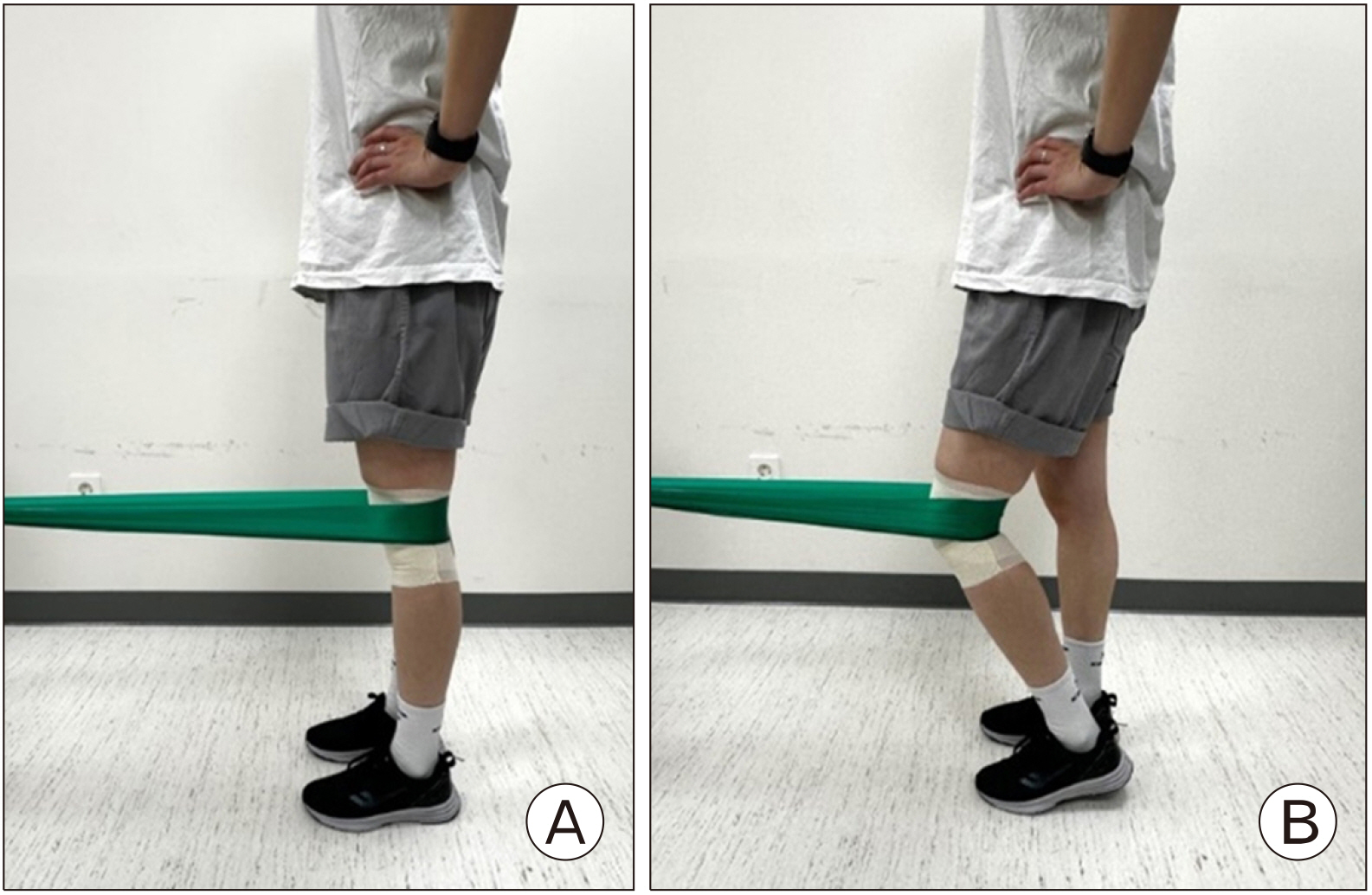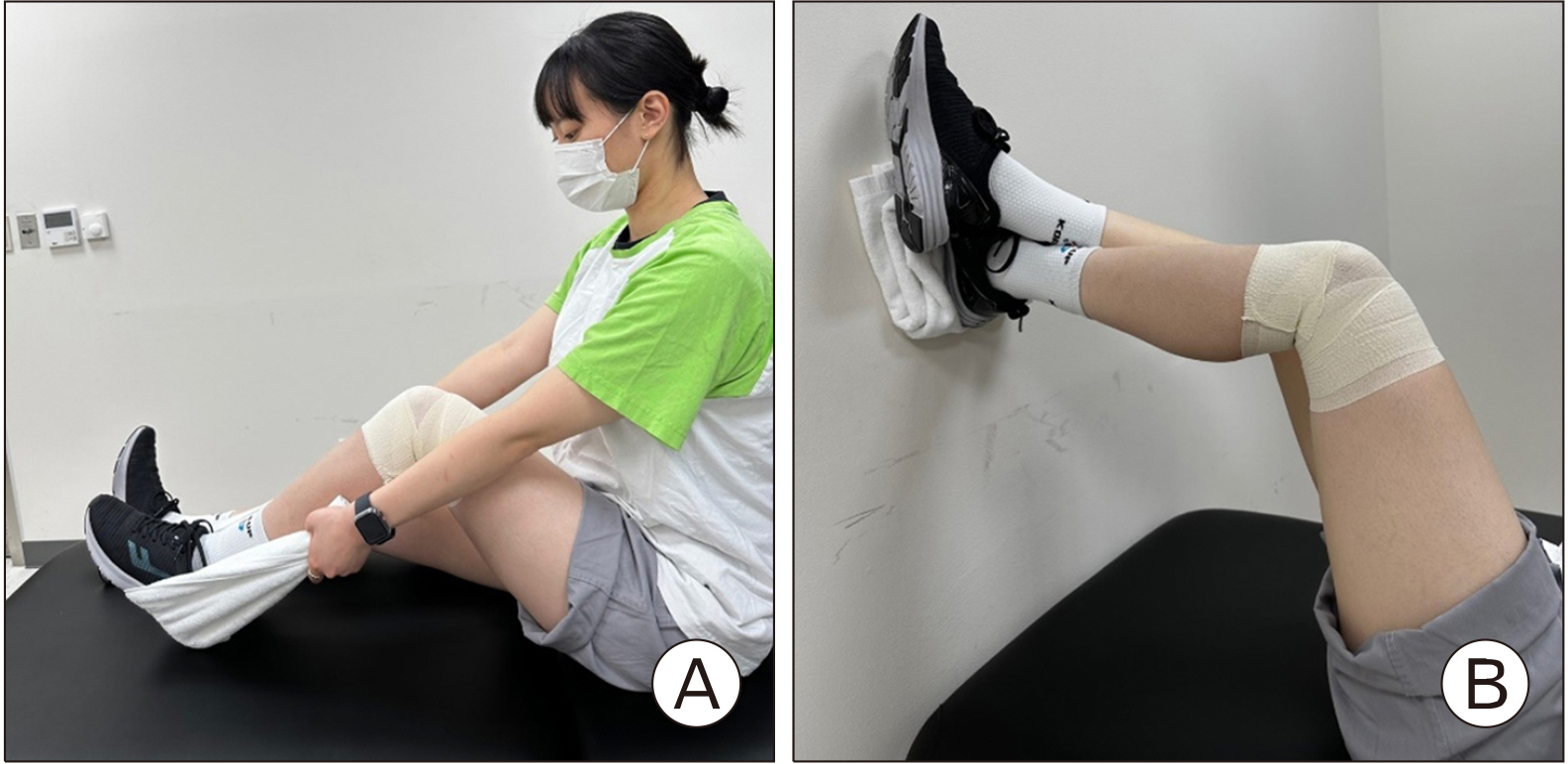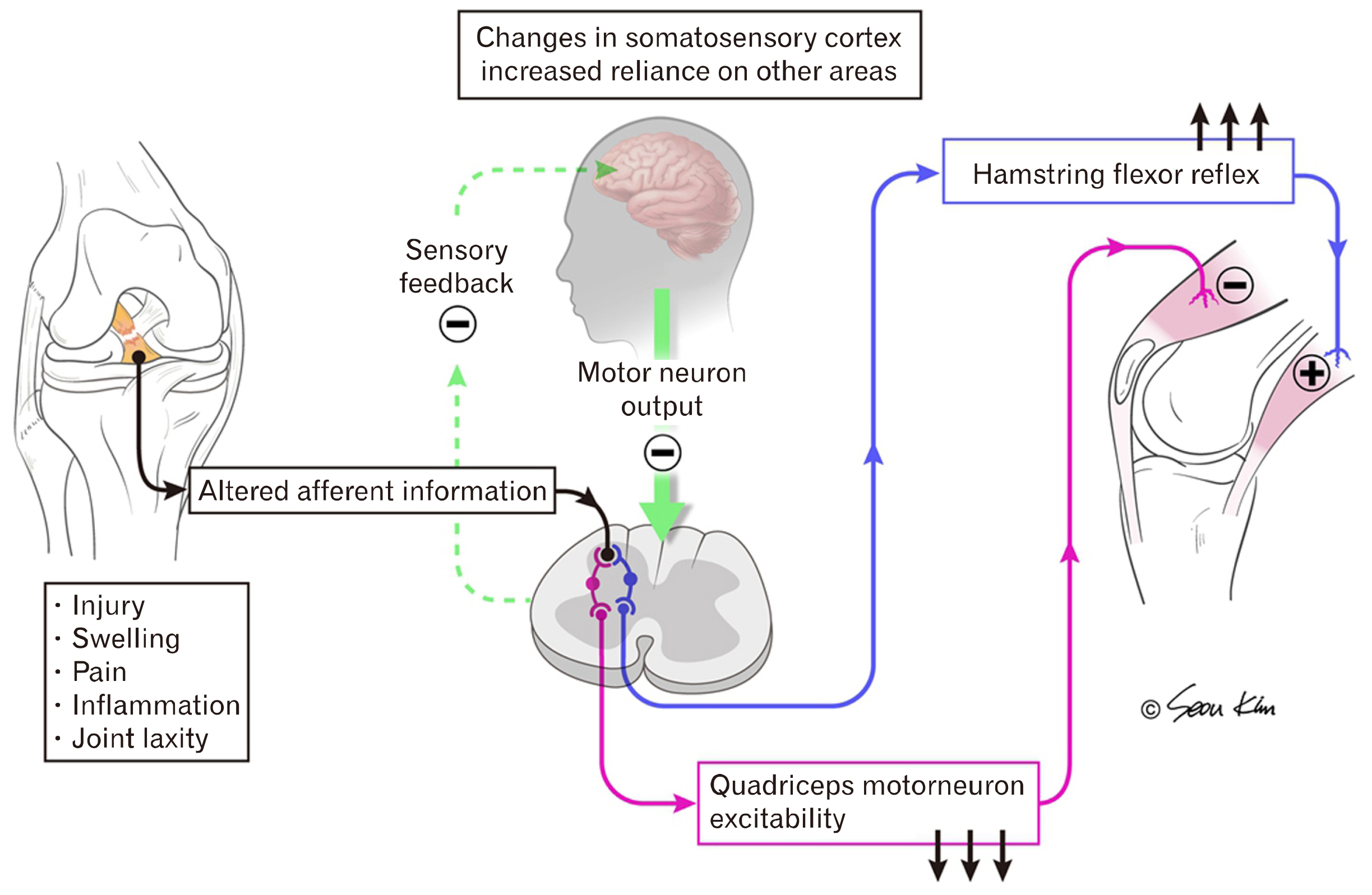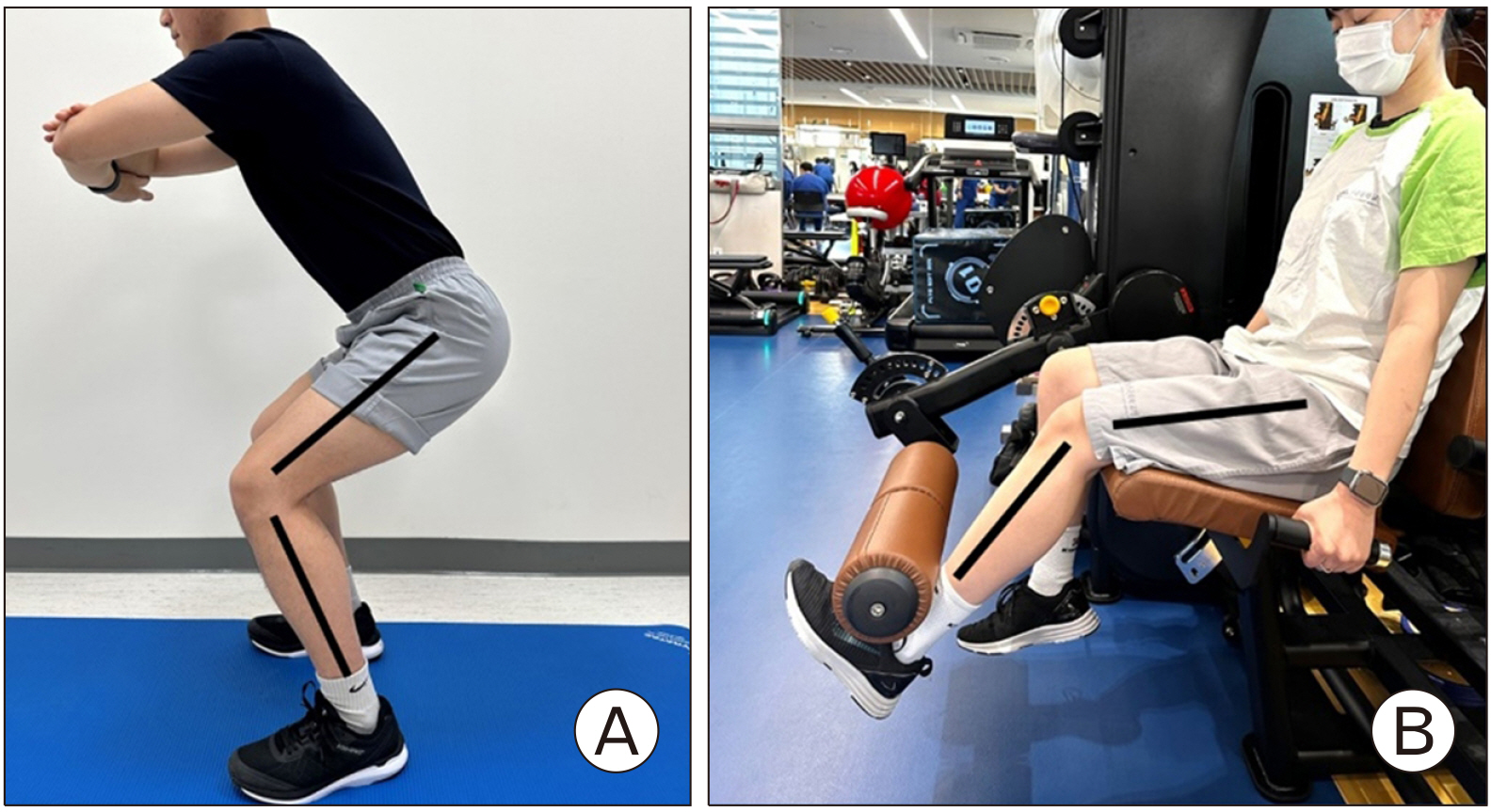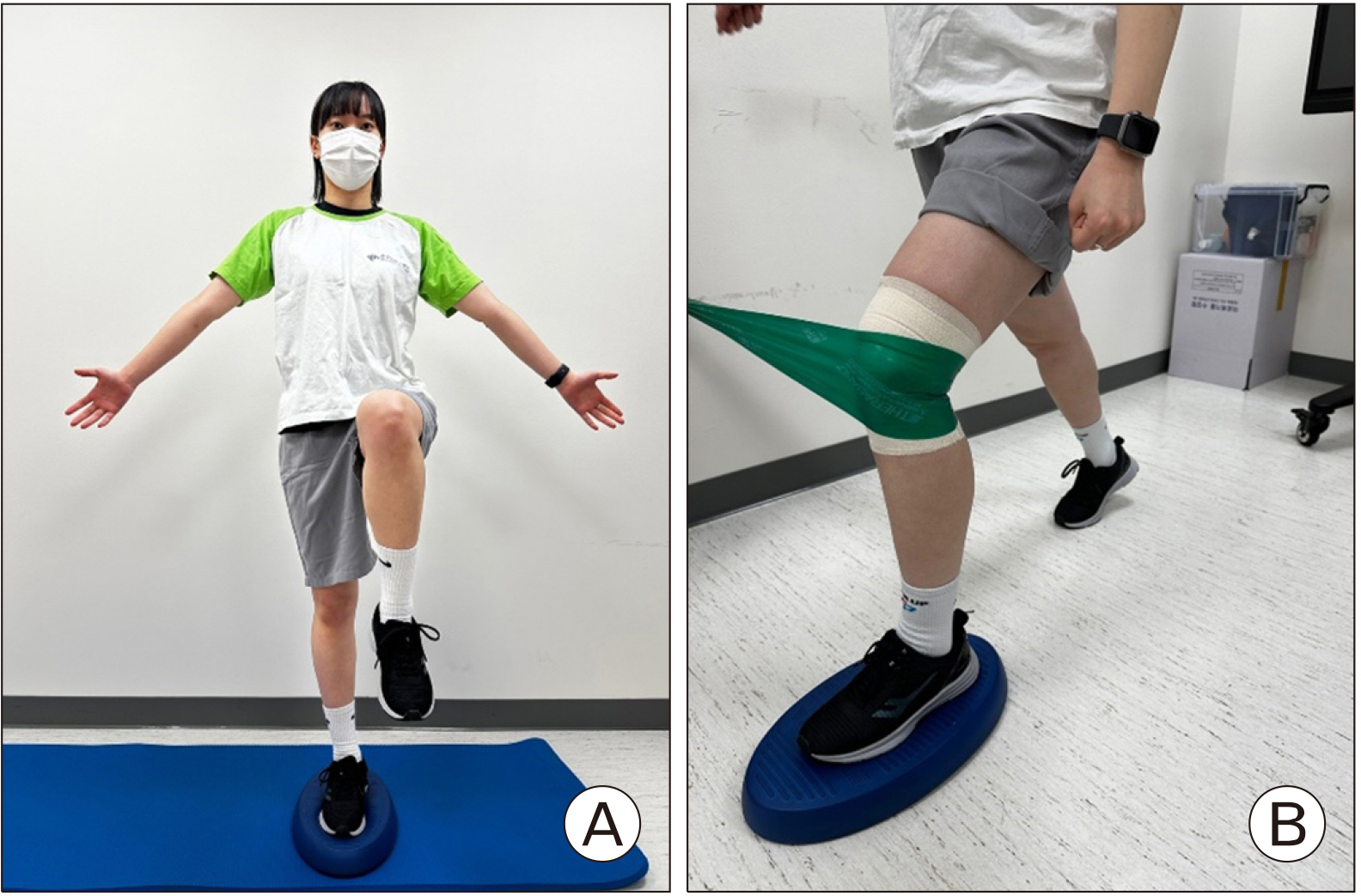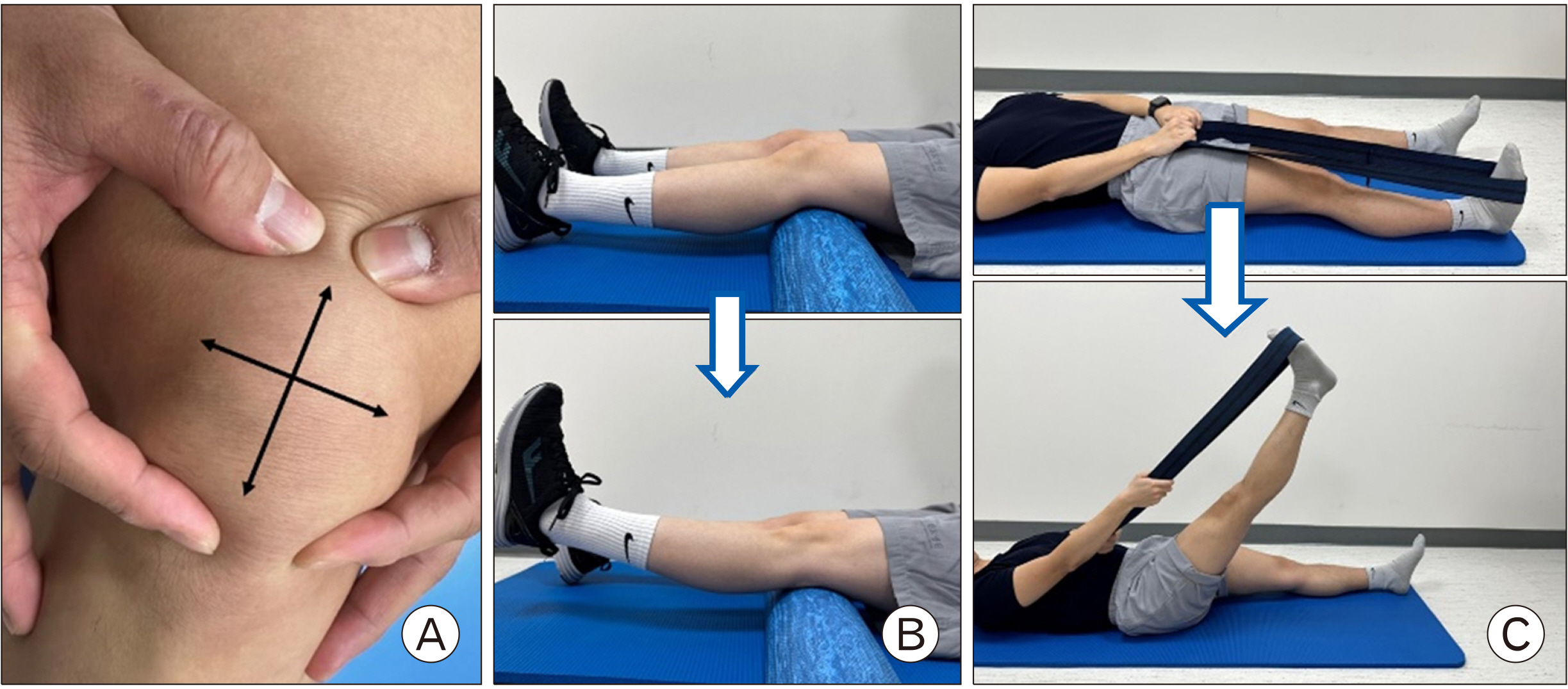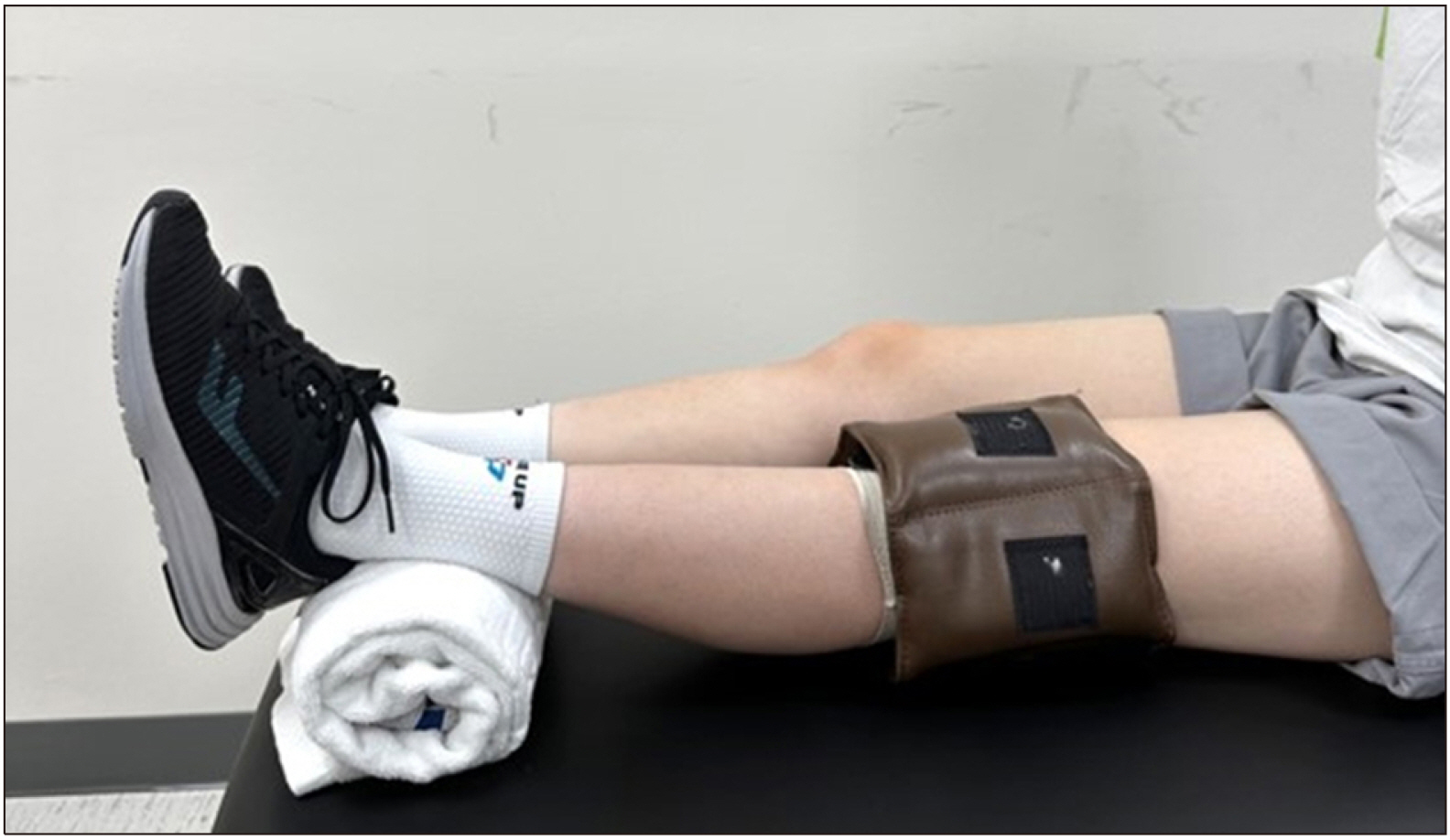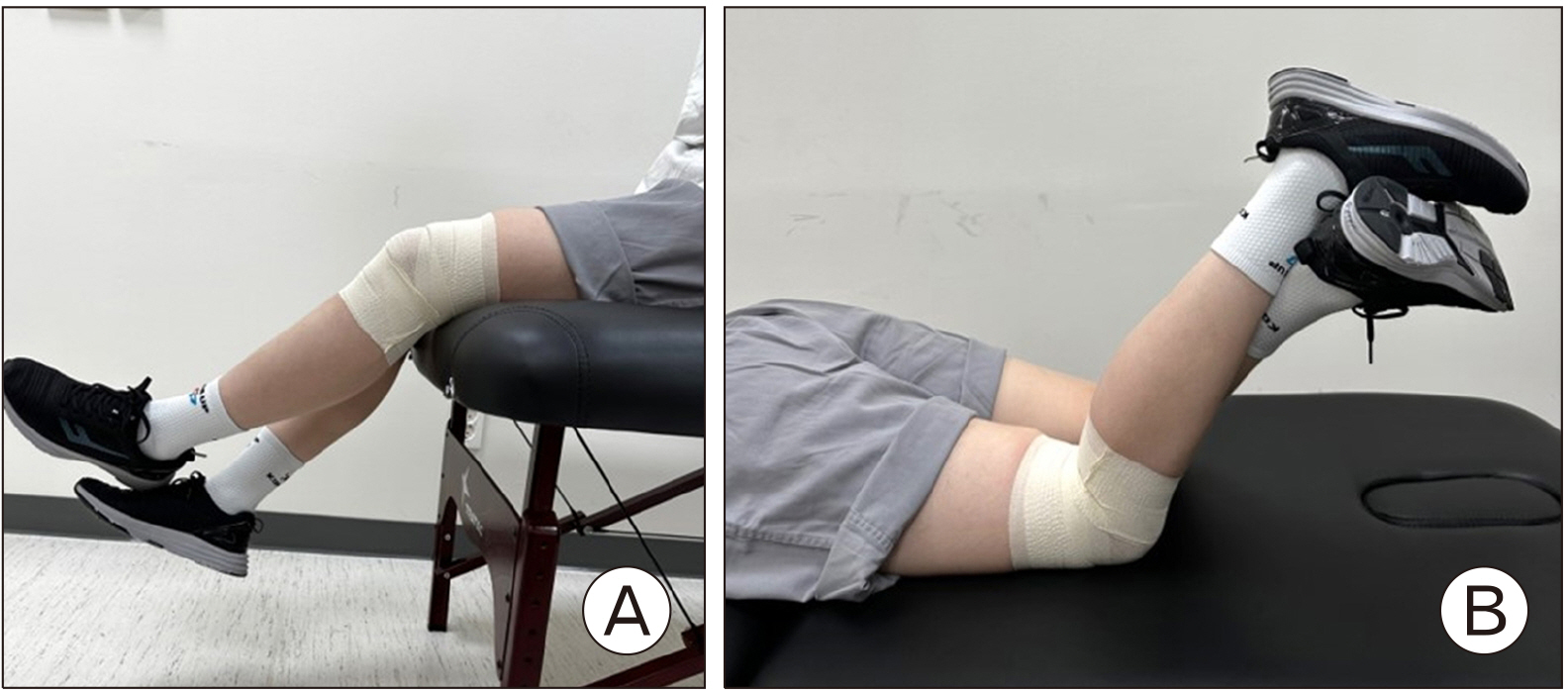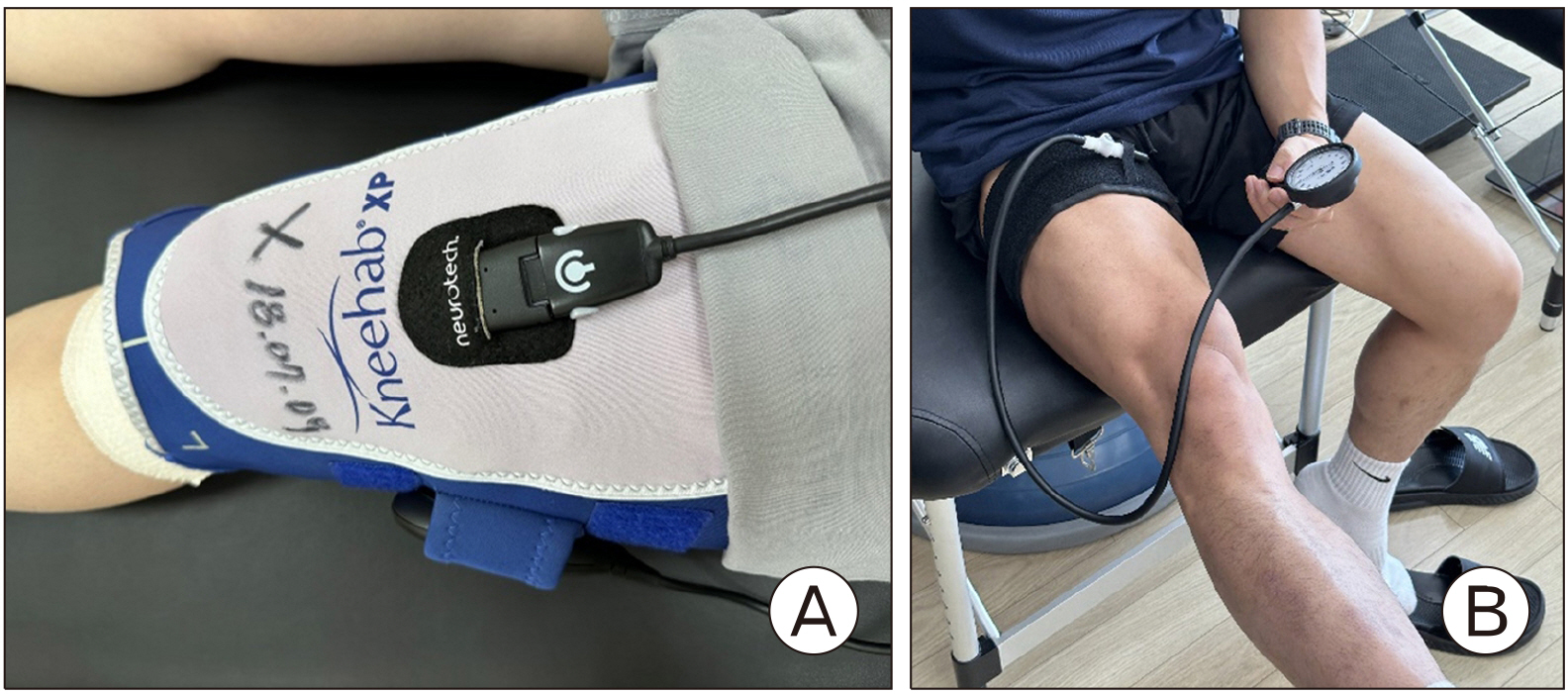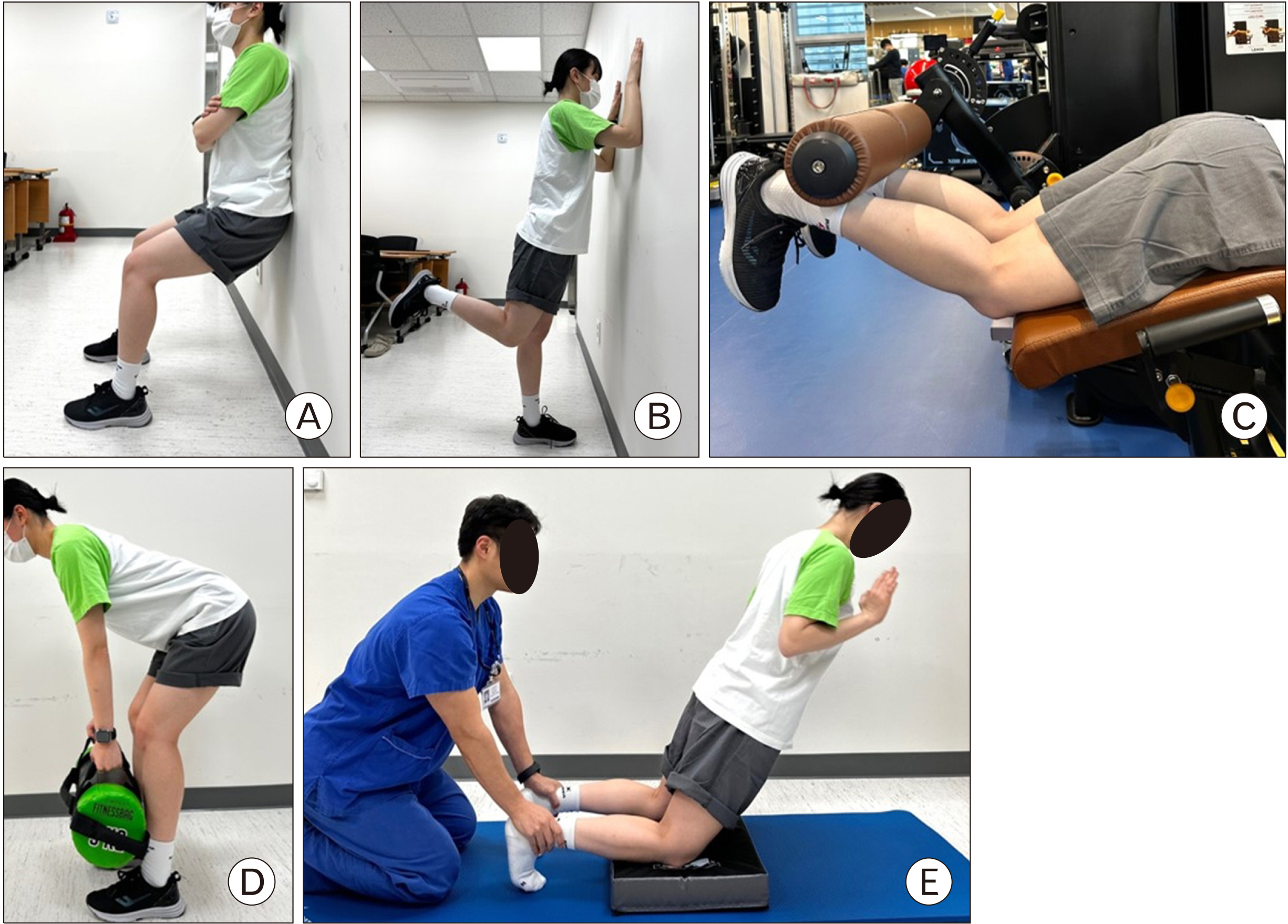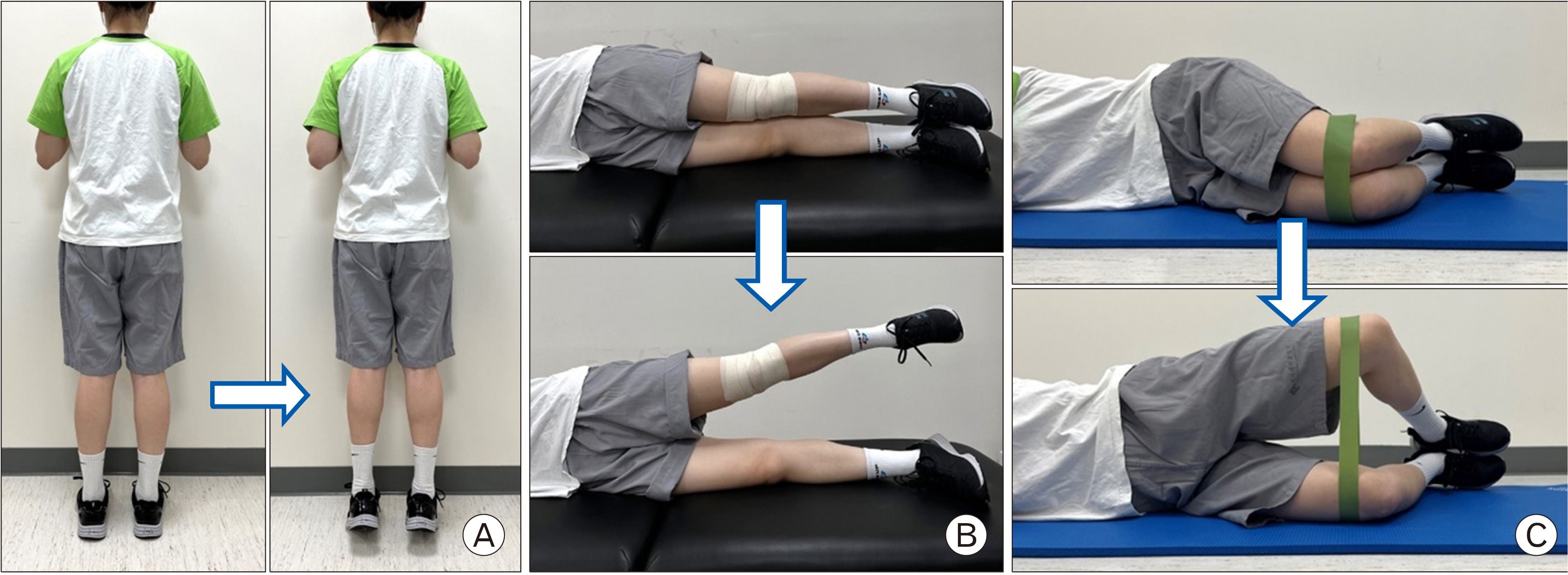Korean J Sports Med.
2024 Jun;42(2):67-85. 10.5763/kjsm.2024.42.2.67.
Functional Recovery Program before and after Anterior Cruciate Ligament Reconstruction: A Current Concepts Review
- Affiliations
-
- 1Sports Medical Center, KonKuk University Medical Center, Seoul, Korea
- 2Department of Health and Exercise Management, Tongwon University, Gwangju, Korea
- 3Seoul Jump Orthopaedic Surgery Clinic, Seoul, Korea
- 4Sports Medical Center, Hanyang University Myongji Hospital, Ilsan, Korea
- KMID: 2556272
- DOI: http://doi.org/10.5763/kjsm.2024.42.2.67
Abstract
- Anterior cruciate ligament (ACL) rupture leads to weakened quadriceps muscle strength and a decline in proprioception, impairing the neuromuscular control of the lower extremities. ACL reconstruction, aimed at addressing such structural and functional instability, has become a primary treatment method for young and active patients. Consequently, there have been significant advancements in surgical techniques, resulting in improved clinical outcomes. However, achieving successful outcomes after ACL reconstruction is not solely dependent on the surgery itself; pre- and postoperative rehabilitation and management are equally crucial. A well-designed functional recovery program based on medical evidence before and after ACL reconstruction plays a vital role in restoring function to preinjury levels. The process of the functional recovery program, from presurgery to sports return, should adhere to certain principles. These principles involve prompt and accurate clinical diagnosis and patient classification after injury, systematic programs addressing joint swelling and inflammation control, reduction of arthrogenic muscle inhibition, restoration of range of motion, muscle strength recovery, and proprioception restoration. Postoperatively, it is essential to go beyond traditional methods (such as range of motion restoration and muscle strengthening) by implementing a functional recovery program that includes enhancement of proprioception and neuromuscular control system from the early stages, considering the biological healing response of the graft. This comprehensive approach is vital for achieving optimal outcomes in the recovery of function after ACL reconstruction.
Keyword
Figure
Reference
-
1. Lee J, Lee K, Moon J, Yoon T. 2022; Force production patterns of muscles surrounding knee during running and cutting maneuvers: a musculoskeletal modeling approach. Asian J Kinesiol. 24:29–38. DOI: 10.15758/ajk.2022.24.1.29.
Article2. Chung KS, Kim JH, Kong DH, Park I, Kim JG, Ha JK. 2022; An increasing trend in the number of anterior cruciate ligament reconstruction in korea: a nationwide epidemiologic study. Clin Orthop Surg. 14:220–6. DOI: 10.4055/cios20276. PMID: 35685966. PMCID: PMC9152897.
Article3. Bisciotti GN, Chamari K, Cena E, et al. 2019; Anterior cruciate ligament injury risk factors in football. J Sports Med Phys Fitness. 59:1724–38. DOI: 10.23736/S0022-4707.19.09563-X. PMID: 31062538.
Article4. Georgoulis AD, Pappa L, Moebius U, et al. 2001; The presence of proprioceptive mechanoreceptors in the remnants of the ruptured ACL as a possible source of re-innervation of the ACL autograft. Knee Surg Sports Traumatol Arthrosc. 9:364–8. DOI: 10.1007/s001670100240. PMID: 11734875.
Article5. Niederer D, Behringer M, Stein T. 2023; Functional outcomes after anterior cruciate ligament reconstruction: unravelling the role of time between injury and surgery, time since reconstruction, age, gender, pain, graft type, and concomitant injuries. BMC Sports Sci Med Rehabil. 15:49. DOI: 10.1186/s13102-023-00663-x. PMID: 37005699. PMCID: PMC10068137.
Article6. Malempati C, Jurjans J, Noehren B, Ireland ML, Johnson DL. 2015; Current rehabilitation concepts for anterior cruciate ligament surgery in athletes. Orthopedics. 38:689–96. DOI: 10.3928/01477447-20151016-07. PMID: 26558662.
Article7. Ardern CL, Webster KE, Taylor NF, Feller JA. 2011; Return to sport following anterior cruciate ligament reconstruction surgery: a systematic review and meta-analysis of the state of play. Br J Sports Med. 45:596–606. DOI: 10.1136/bjsm.2010.076364. PMID: 21398310.
Article8. Carter HM, Littlewood C, Webster KE, Smith BE. 2020; The effectiveness of preoperative rehabilitation programmes on postoperative outcomes following anterior cruciate ligament (ACL) reconstruction: a systematic review. BMC Musculoskelet Disord. 21:647. DOI: 10.1186/s12891-020-03676-6. PMID: 33010802. PMCID: PMC7533034.
Article9. Failla MJ, Logerstedt DS, Grindem H, et al. 2016; Does extended preoperative rehabilitation influence outcomes 2 years after acl reconstruction? A comparative effectiveness study between the MOON and Delaware-Oslo ACL cohorts. Am J Sports Med. 44:2608–14. DOI: 10.1177/0363546516652594. PMID: 27416993. PMCID: PMC5537599.
Article10. Piedade SR, Leite Arruda BP, de Vasconcelos RA, Parker DA, Maffulli N. 2023; Rehabilitation following surgical reconstruction for anterior cruciate ligament insufficiency: what has changed since the 1960s? State of the art. J ISAKOS. 8:153–62. DOI: 10.1016/j.jisako.2022.10.001. PMID: 36410671.11. de Valk EJ, Moen MH, Winters M, Bakker EW, Tamminga R, van der Hoeven H. 2013; Preoperative patient and injury factors of successful rehabilitation after anterior cruciate ligament reconstruction with single-bundle techniques. Arthroscopy. 29:1879–95. DOI: 10.1016/j.arthro.2013.07.273. PMID: 24209682.
Article12. Potts G, Reid D, Larmer P. 2022; The effectiveness of preoperative exercise programmes on quadriceps strength prior to and following anterior cruciate ligament (ACL) reconstruction: a systematic review. Phys Ther Sport. 54:16–28. DOI: 10.1016/j.ptsp.2021.12.004. PMID: 34933208.
Article13. Cunha J, Solomon DJ. 2022; ACL prehabilitation improves postoperative strength and motion and return to sport in athletes. Arthrosc Sports Med Rehabil. 4:e65–9. DOI: 10.1016/j.asmr.2021.11.001. PMID: 35141537. PMCID: PMC8811524.
Article14. Pedersen M, Grindem H, Berg B, et al. 2022; Four distinct 5-year trajectories of knee function emerge in patients who followed the Delaware-Oslo ACL cohort treatment algorithm. Am J Sports Med. 50:2944–52. DOI: 10.1177/03635465221116313. PMID: 35975945. PMCID: PMC9442772.
Article15. van Melick N, van Cingel RE, Brooijmans F, et al. 2016; Evidence-based clinical practice update: practice guidelines for anterior cruciate ligament rehabilitation based on a systematic review and multidisciplinary consensus. Br J Sports Med. 50:1506–15. DOI: 10.1136/bjsports-2015-095898. PMID: 27539507.
Article16. Eastlack ME, Axe MJ, Snyder-Mackler L. 1999; Laxity, instability, and functional outcome after ACL injury: copers versus noncopers. Med Sci Sports Exerc. 31:210–5. DOI: 10.1097/00005768-199902000-00002. PMID: 10063808.
Article17. Fitzgerald GK, Axe MJ, Snyder-Mackler L. 2000; A decision-making scheme for returning patients to high-level activity with nonoperative treatment after anterior cruciate ligament rupture. Knee Surg Sports Traumatol Arthrosc. 8:76–82. DOI: 10.1007/s001670050190. PMID: 10795668.
Article18. Thoma LM, Grindem H, Logerstedt D, et al. 2019; Coper classification early after anterior cruciate ligament rupture changes with progressive neuromuscular and strength training and is associated with 2-year success: the Delaware-Oslo ACL cohort study. Am J Sports Med. 47:807–14. DOI: 10.1177/0363546519825500. PMID: 30790527. PMCID: PMC6546284.
Article19. Palmieri-Smith RM, Kreinbrink J, Ashton-Miller JA, Wojtys EM. 2007; Quadriceps inhibition induced by an experimental knee joint effusion affects knee joint mechanics during a single-legged drop landing. Am J Sports Med. 35:1269–75. DOI: 10.1177/0363546506296417. PMID: 17244901.
Article20. Torry MR, Decker MJ, Millett PJ, Steadman JR, Sterett WI. 2005; The effects of knee joint effusion on quadriceps electromyography during jogging. J Sports Sci Med. 4:1–8.21. Scanlan SF, Donahue JP, Andriacchi TP. 2014; The in vivo relationship between anterior neutral tibial position and loss of knee extension after transtibial ACL reconstruction. Knee. 21:74–9. DOI: 10.1016/j.knee.2013.06.003. PMID: 23830645.
Article22. Shelbourne KD, Gray T. 2009; Minimum 10-year results after anterior cruciate ligament reconstruction: how the loss of normal knee motion compounds other factors related to the development of osteoarthritis after surgery. Am J Sports Med. 37:471–80. DOI: 10.1177/0363546508326709. PMID: 19059893.
Article23. Wasilewski SA, Covall DJ, Cohen S. 1993; Effect of surgical timing on recovery and associated injuries after anterior cruciate ligament reconstruction. Am J Sports Med. 21:338–42. DOI: 10.1177/036354659302100302. PMID: 8346744.
Article24. Wilk KE, Macrina LC, Cain EL, Dugas JR, Andrews JR. 2012; Recent advances in the rehabilitation of anterior cruciate ligament injuries. J Orthop Sports Phys Ther. 42:153–71. DOI: 10.2519/jospt.2012.3741. PMID: 22382825.
Article25. Sonnery-Cottet B, Saithna A, Quelard B, et al. 2019; Arthrogenic muscle inhibition after ACL reconstruction: a scoping review of the efficacy of interventions. Br J Sports Med. 53:289–98. DOI: 10.1136/bjsports-2017-098401. PMID: 30194224. PMCID: PMC6579490.
Article26. Yasuda K, Ohkoshi Y, Tanabe Y, Kaneda K. 1991; Muscle weakness after anterior cruciate ligament reconstruction using patellar and quadriceps tendons. Bull Hosp Jt Dis Orthop Inst. 51:175–85.27. Rice DA, McNair PJ. 2010; Quadriceps arthrogenic muscle inhibition: neural mechanisms and treatment perspectives. Semin Arthritis Rheum. 40:250–66. DOI: 10.1016/j.semarthrit.2009.10.001. PMID: 19954822.
Article28. Delaloye JR, Murar J, Vieira TD, et al. 2020; Knee extension deficit in the early postoperative period predisposes to cyclops syndrome after anterior cruciate ligament reconstruction: a risk factor analysis in 3633 patients from the SANTI study group database. Am J Sports Med. 48:565–72. DOI: 10.1177/0363546519897064. PMID: 31930921.
Article29. Feil S, Newell J, Minogue C, Paessler HH. 2011; The effectiveness of supplementing a standard rehabilitation program with superimposed neuromuscular electrical stimulation after anterior cruciate ligament reconstruction: a prospective, randomized, single-blind study. Am J Sports Med. 39:1238–47. DOI: 10.1177/0363546510396180. PMID: 21343386.
Article30. Ross MD, Denegar CR, Winzenried JA. 2001; Implementation of open and closed kinetic chain quadriceps strengthening exercises after anterior cruciate ligament reconstruction. J Strength Cond Res. 15:466–73. DOI: 10.1519/00124278-200111000-00011. PMID: 11726258.
Article31. Fukuda TY, Fingerhut D, Moreira VC, et al. 2013; Open kinetic chain exercises in a restricted range of motion after anterior cruciate ligament reconstruction: a randomized controlled clinical trial. Am J Sports Med. 41:788–94. DOI: 10.1177/0363546513476482. PMID: 23423316.
Article32. Isberg J, Faxén E, Brandsson S, Eriksson BI, Kärrholm J, Karlsson J. 2006; Early active extension after anterior cruciate ligament reconstruction does not result in increased laxity of the knee. Knee Surg Sports Traumatol Arthrosc. 14:1108–15. DOI: 10.1007/s00167-006-0138-2. PMID: 16955299.
Article33. Tagesson S, Oberg B, Good L, Kvist J. 2008; A comprehensive rehabilitation program with quadriceps strengthening in closed versus open kinetic chain exercise in patients with anterior cruciate ligament deficiency: a randomized clinical trial evaluating dynamic tibial translation and muscle function. Am J Sports Med. 36:298–307. DOI: 10.1177/0363546507307867. PMID: 17940146.
Article34. Jean LM, Gross DP, Chiu LZ. 2022; Knee Extensor Strength in Anterior Cruciate Ligament-Deficient Individuals Following Normal and Modified Squats: A Randomized Controlled Trial. J Strength Cond Res. 36:47–54. DOI: 10.1519/JSC.0000000000004165. PMID: 34941609.
Article35. Yosmaoglu HB, Baltaci G, Kaya D, Ozer H. 2011; Tracking ability, motor coordination, and functional determinants after anterior cruciate ligament reconstruction. J Sport Rehabil. 20:207–18. DOI: 10.1123/jsr.20.2.207. PMID: 21576712.
Article36. Cooper RL, Taylor NF, Feller JA. 2005; A systematic review of the effect of proprioceptive and balance exercises on people with an injured or reconstructed anterior cruciate ligament. Res Sports Med. 13:163–78. DOI: 10.1080/15438620590956197. PMID: 16392446.
Article37. Emami Meibodi MK, Naghizad J, Shamsoddini A. 2022; The effect of balance rehabilitation interventions with and without visual feedback on balance and proprioception of knee in patients with anterior cruciate ligament injury: a randomized clinical trial. Sport Sci Health. 18:125–9. DOI: 10.1007/s11332-021-00782-3.
Article38. Chmielewski TL, Hurd WJ, Rudolph KS, Axe MJ, Snyder-Mackler L. 2005; Perturbation training improves knee kinematics and reduces muscle co-contraction after complete unilateral anterior cruciate ligament rupture. Phys Ther. 85:740–54. DOI: 10.1093/ptj/85.8.740. PMID: 16048422.
Article39. Mehl J, Diermeier T, Herbst E, et al. 2018; Evidence-based concepts for prevention of knee and ACL injuries. 2017 guidelines of the ligament committee of the German Knee Society (DKG). Arch Orthop Trauma Surg. 138:51–61. DOI: 10.1007/s00402-017-2809-5. PMID: 28983841.
Article40. Carter HM, Littlewood C, Webster KE, Smith BE. 2020; The effectiveness of preoperative rehabilitation programmes on postoperative outcomes following anterior cruciate ligament (ACL) reconstruction: a systematic review. BMC Musculoskelet Disord. 21:647. DOI: 10.1186/s12891-020-03676-6. PMID: 33010802. PMCID: PMC7533034.
Article41. Hartigan E, Axe MJ, Snyder-Mackler L. 2009; Perturbation training prior to ACL reconstruction improves gait asymmetries in non-copers. J Orthop Res. 27:724–9. DOI: 10.1002/jor.20754. PMID: 19023893. PMCID: PMC3597104.
Article42. Shaarani SR, O'Hare C, Quinn A, Moyna N, Moran R, O'Byrne JM. 2013; Effect of prehabilitation on the outcome of anterior cruciate ligament reconstruction. Am J Sports Med. 41:2117–27. DOI: 10.1177/0363546513493594. PMID: 23845398.
Article43. Kim DK, Hwang JH, Park WH. 2015; Effects of 4 weeks preoperative exercise on knee extensor strength after anterior cruciate ligament reconstruction. J Phys Ther Sci. 27:2693–6. DOI: 10.1589/jpts.27.2693. PMID: 26504270. PMCID: PMC4616071.
Article44. Hanada M, Yoshikura T, Matsuyama Y. 2019; Muscle recovery at 1 year after the anterior cruciate ligament reconstruction surgery is associated with preoperative and early postoperative muscular strength of the knee extension. Eur J Orthop Surg Traumatol. 29:1759–64. DOI: 10.1007/s00590-019-02479-3. PMID: 31240385.
Article45. Escamilla RF, Macleod TD, Wilk KE, Paulos L, Andrews JR. 2012; Anterior cruciate ligament strain and tensile forces for weight-bearing and non-weight-bearing exercises: a guide to exercise selection. J Orthop Sports Phys Ther. 42:208–20. DOI: 10.2519/jospt.2012.3768. PMID: 22387600.
Article46. Perriman A, Leahy E, Semciw AI. 2018; The effect of open-versus closed-kinetic-chain exercises on anterior tibial laxity, strength, and function following anterior cruciate ligament reconstruction: a systematic review and meta-analysis. J Orthop Sports Phys Ther. 48:552–66. DOI: 10.2519/jospt.2018.7656. PMID: 29685058.
Article47. Paulos L, Noyes FR, Grood E, Butler DL. 1981; Knee rehabilitation after anterior cruciate ligament reconstruction and repair. Am J Sports Med. 9:140–9. DOI: 10.1177/036354658100900303. PMID: 7235109.
Article48. Noyes FR, Mangine RE, Barber S. 1987; Early knee motion after open and arthroscopic anterior cruciate ligament reconstruction. Am J Sports Med. 15:149–60. DOI: 10.1177/036354658701500210. PMID: 3555129.
Article49. Kurosaka M, Yoshiya S, Andrish JT. 1987; A biomechanical comparison of different surgical techniques of graft fixation in anterior cruciate ligament reconstruction. Am J Sports Med. 15:225–9. DOI: 10.1177/036354658701500306. PMID: 3303979.
Article50. Shelbourne KD, Nitz P. 1990; Accelerated rehabilitation after anterior cruciate ligament reconstruction. Am J Sports Med. 18:292–9. DOI: 10.1177/036354659001800313. PMID: 2372081.
Article51. Nyland J, Mattocks A, Kibbe S, Kalloub A, Greene JW, Caborn DN. 2016; Anterior cruciate ligament reconstruction, rehabilitation, and return to play: 2015 update. Open Access J Sports Med. 7:21–32. DOI: 10.2147/OAJSM.S72332. PMID: 26955296. PMCID: PMC4772947.
Article52. Andrade R, Pereira R, van Cingel R, Staal JB, Espregueira-Mendes J. 2020; How should clinicians rehabilitate patients after ACL reconstruction? A systematic review of clinical practice guidelines (CPGs) with a focus on quality appraisal (AGREE II). Br J Sports Med. 54:512–9. DOI: 10.1136/bjsports-2018-100310. PMID: 31175108.
Article53. Adams D, Logerstedt DS, Hunter-Giordano A, Axe MJ, Snyder-Mackler L. 2012; Current concepts for anterior cruciate ligament reconstruction: a criterion-based rehabilitation progression. J Orthop Sports Phys Ther. 42:601–14. DOI: 10.2519/jospt.2012.3871. PMID: 22402434. PMCID: PMC3576892.
Article54. Quelard B, Sonnery-Cottet B, Zayni R, Ogassawara R, Prost T, Chambat P. 2010; Preoperative factors correlating with prolonged range of motion deficit after anterior cruciate ligament reconstruction. Am J Sports Med. 38:2034–9. DOI: 10.1177/0363546510370198. PMID: 20702861.
Article55. Biggs A, Jenkins WL, Urch SE, Shelbourne KD. 2009; Rehabilitation for patients following ACL reconstruction: a knee symmetry model. N Am J Sports Phys Ther. 4:2–12.56. Shelbourne KD, Freeman H, Gray T. 2012; Osteoarthritis after anterior cruciate ligament reconstruction: the importance of regaining and maintaining full range of motion. Sports Health. 4:79–85. DOI: 10.1177/1941738111430201. PMID: 23016073. PMCID: PMC3435893.
Article57. Noll S, Garrison JC, Bothwell J, Conway JE. 2015; Knee extension range of motion at 4 weeks is related to knee extension loss at 12 weeks after anterior cruciate ligament reconstruction. Orthop J Sports Med. 3:2325967115583632. DOI: 10.1177/2325967115583632. PMID: 26675061. PMCID: PMC4622346.
Article58. Buckthorpe M, Della Villa F. 2020; Optimising the 'mid-stage' training and testing process after ACL reconstruction. Sports Med. 50:657–78. DOI: 10.1007/s40279-019-01222-6. PMID: 31782065.
Article59. Marques FD, Barbosa PH, Alves PR, et al. 2020; Anterior knee pain after anterior cruciate ligament reconstruction. Orthop J Sports Med. 8:2325967120961082. DOI: 10.1177/2325967120961082. PMID: 33195725. PMCID: PMC7605008.
Article60. Pinto FG, Thaunat M, Daggett M, et al. 2017; Hamstring contracture after ACL reconstruction is associated with an increased risk of cyclops syndrome. Orthop J Sports Med. 5:2325967116684121. DOI: 10.1177/2325967116684121. PMID: 28203602. PMCID: PMC5298440.61. Wilk KE, Arrigo CA. 2017; Rehabilitation principles of the anterior cruciate ligament reconstructed knee: twelve steps for successful progression and return to play. Clin Sports Med. 36:189–232. DOI: 10.1016/j.csm.2016.08.012. PMID: 27871658.
Article62. Kotsifaki R, Korakakis V, King E, et al. 2023; Aspetar clinical practice guideline on rehabilitation after anterior cruciate ligament reconstruction. Br J Sports Med. 57:500–14. DOI: 10.1136/bjsports-2022-106158. PMID: 36731908.
Article63. Lin PE, Sigward SM. 2020; Influence of hamstrings on knee moments during loading response of gait in individuals following ACL reconstruction. J Orthop Res. 38:378–86. DOI: 10.1002/jor.24465. PMID: 31502699.
Article64. Harput G, Howard JS, Mattacola C. 2016; Comparison of muscle activation levels between healthy individuals and persons who have undergone anterior cruciate ligament reconstruction during different phases of weight-bearing exercises. J Orthop Sports Phys Ther. 46:984–92. DOI: 10.2519/jospt.2016.5896. PMID: 27733087.
Article65. Wright RW, Preston E, Fleming BC, et al. 2008; A systematic review of anterior cruciate ligament reconstruction rehabilitation: part I. Continuous passive motion, early weight bearing, postoperative bracing, and home-based rehabilitation. J Knee Surg. 21:217–24. DOI: 10.1055/s-0030-1247822. PMID: 18686484. PMCID: PMC3692363.
Article66. MARS Group. 2019; Rehabilitation predictors of clinical outcome following revision ACL reconstruction in the MARS Cohort. J Bone Joint Surg Am. 101:779–86. DOI: 10.2106/JBJS.18.00397. PMID: 31045665. PMCID: PMC7292503.67. Fan Z, Yan J, Zhou Z, et al. 2022; Delayed versus accelerated weight-bearing rehabilitation protocol following anterior cruciate ligament reconstruction: a systematic review and meta-analysis. J Rehabil Med. 54:jrm00260. DOI: 10.2340/jrm.v53.1438. PMID: 35037693. PMCID: PMC8892302.
Article68. Tyler TF, McHugh MP, Gleim GW, Nicholas SJ. 1998; The effect of immediate weightbearing after anterior cruciate ligament reconstruction. Clin Orthop Relat Res. 141–8. DOI: 10.1097/00003086-199812000-00019. PMID: 9917711.
Article69. Tajima T, Yamaguchi N, Nagasawa M, Morita Y, Nakamura Y, Chosa E. 2019; Early weight-bearing after anterior cruciate ligament reconstruction with hamstring grafts induce femoral bone tunnel enlargement: a prospective clinical and radiographic study. BMC Musculoskelet Disord. 20:274. DOI: 10.1186/s12891-019-2653-6. PMID: 31159789. PMCID: PMC6547478.
Article70. Rizer M, Foremny GB, Rush A, et al. 2017; Anterior cruciate ligament reconstruction tunnel size: causes of tunnel enlargement and implications for single versus two-stage revision reconstruction. Skeletal Radiol. 46:161–9. DOI: 10.1007/s00256-016-2535-z. PMID: 27885380.
Article71. Buckthorpe M, La Rosa G, Villa FD. 2019; Restoring knee extensor strength after anterior cruciate ligament reconstruction: a clinical commentary. Int J Sports Phys Ther. 14:159–72. DOI: 10.26603/ijspt20190159. PMID: 30746302. PMCID: PMC6350662.
Article72. Bodkin S, Goetschius J, Hertel J, Hart J. 2017; Relationships of muscle function and subjective knee function in patients after ACL reconstruction. Orthop J Sports Med. 5:2325967117719041. DOI: 10.1177/2325967117719041. PMID: 28804728. PMCID: PMC5533264.
Article73. Zwolski C, Schmitt LC, Quatman-Yates C, Thomas S, Hewett TE, Paterno MV. 2015; The influence of quadriceps strength asymmetry on patient-reported function at time of return to sport after anterior cruciate ligament reconstruction. Am J Sports Med. 43:2242–9. DOI: 10.1177/0363546515591258. PMID: 26183172.
Article74. Snyder-Mackler L, Delitto A, Bailey SL, Stralka SW. 1995; Strength of the quadriceps femoris muscle and functional recovery after reconstruction of the anterior cruciate ligament. A prospective, randomized clinical trial of electrical stimulation. J Bone Joint Surg Am. 77:1166–73. DOI: 10.2106/00004623-199508000-00004. PMID: 7642660.
Article75. Lewek M, Rudolph K, Axe M, Snyder-Mackler L. 2002; The effect of insufficient quadriceps strength on gait after anterior cruciate ligament reconstruction. Clin Biomech (Bristol, Avon). 17:56–63. DOI: 10.1016/S0268-0033(01)00097-3.
Article76. Thomas AC, Villwock M, Wojtys EM, Palmieri-Smith RM. 2013; Lower extremity muscle strength after anterior cruciate ligament injury and reconstruction. J Athl Train. 48:610–20. DOI: 10.4085/1062-6050-48.3.23. PMID: 24067150. PMCID: PMC3784362.
Article77. Palmieri-Smith RM, Lepley LK. 2015; Quadriceps strength asymmetry after anterior cruciate ligament reconstruction alters knee joint biomechanics and functional performance at time of return to activity. Am J Sports Med. 43:1662–9. DOI: 10.1177/0363546515578252. PMID: 25883169. PMCID: PMC4758854.
Article78. Grindem H, Snyder-Mackler L, Moksnes H, Engebretsen L, Risberg MA. 2016; Simple decision rules can reduce reinjury risk by 84% after ACL reconstruction: the Delaware-Oslo ACL cohort study. Br J Sports Med. 50:804–8. DOI: 10.1136/bjsports-2016-096031. PMID: 27162233. PMCID: PMC4912389.
Article79. Shelbourne KD, Wilckens JH, Mollabashy A, DeCarlo M. 1991; Arthrofibrosis in acute anterior cruciate ligament reconstruction. The effect of timing of reconstruction and rehabilitation. Am J Sports Med. 19:332–6. DOI: 10.1177/036354659101900402. PMID: 1897645.
Article80. Harput G, Kilinc HE, Ozer H, Baltaci G, Mattacola CG. 2015; Quadriceps and hamstring strength recovery during early neuromuscular rehabilitation after ACL hamstring-tendon autograft reconstruction. J Sport Rehabil. 24:398–404. DOI: 10.1123/jsr.2014-0224. PMID: 26633588.
Article81. Hopkins JT, Ingersoll CD. 2000; Arthrogenic muscle inhibition: a limiting factor in joint rehabilitation. J Sport Rehabil. 9:135–59. DOI: 10.1123/jsr.9.2.135.
Article82. Buckthorpe M, Gokeler A, Herrington L, et al. 2024; Optimising the early-stage rehabilitation process post-ACL reconstruction. Sports Med. 54:49–72. DOI: 10.1007/s40279-023-01934-w. PMID: 37787846.
Article83. Hopkins J, Ingersoll CD, Edwards J, Klootwyk TE. 2002; Cryotherapy and transcutaneous electric neuromuscular stimulation decrease arthrogenic muscle inhibition of the vastus medialis after knee joint effusion. J Athl Train. 37:25–31.84. Binder-Macleod SA, Halden EE, Jungles KA. 1995; Effects of stimulation intensity on the physiological responses of human motor units. Med Sci Sports Exerc. 27:556–65. DOI: 10.1249/00005768-199504000-00014. PMID: 7791587.
Article85. Trimble MH, Enoka RM. 1991; Mechanisms underlying the training effects associated with neuromuscular electrical stimulation. Phys Ther. 71:273–82. DOI: 10.1093/ptj/71.4.273. PMID: 2008451.
Article86. Cho SI, Kim JW, Nam SS, Moon HW, Jung WS. 2023; Effects of a rehabilitation exercise program using electro muscle stimulation following anterior cruciate ligament reconstruction on the circumference, activity, and function of the quadriceps muscle. Appl Sci. 13:4153. DOI: 10.3390/app13074153.
Article87. Hauger AV, Reiman MP, Bjordal JM, Sheets C, Ledbetter L, Goode AP. 2018; Neuromuscular electrical stimulation is effective in strengthening the quadriceps muscle after anterior cruciate ligament surgery. Knee Surg Sports Traumatol Arthrosc. 26:399–410. DOI: 10.1007/s00167-017-4669-5. PMID: 28819679.
Article88. Cognetti DJ, Sheean AJ, Owens JG. 2022; Blood flow restriction therapy and its use for rehabilitation and return to sport: physiology, application, and guidelines for implementation. Arthrosc Sports Med Rehabil. 4:e71–6. DOI: 10.1016/j.asmr.2021.09.025. PMID: 35141538. PMCID: PMC8811521.
Article89. Ohta H, Kurosawa H, Ikeda H, Iwase Y, Satou N, Nakamura S. 2003; Low-load resistance muscular training with moderate restriction of blood flow after anterior cruciate ligament reconstruction. Acta Orthop Scand. 74:62–8. DOI: 10.1080/00016470310013680. PMID: 12635796.
Article90. Wengle L, Migliorini F, Leroux T, Chahal J, Theodoropoulos J, Betsch M. 2022; The effects of blood flow restriction in patients undergoing knee surgery: a systematic review and meta-analysis. Am J Sports Med. 50:2824–33. DOI: 10.1177/03635465211027296. PMID: 34406084. PMCID: PMC9354069.
Article91. Hughes L, Paton B, Rosenblatt B, Gissane C, Patterson SD. 2017; Blood flow restriction training in clinical musculoskeletal rehabilitation: a systematic review and meta-analysis. Br J Sports Med. 51:1003–11. DOI: 10.1136/bjsports-2016-097071. PMID: 28259850.
Article92. Jacobs E, Rolnick N, Wezenbeek E, et al. 2023; Investigating the autoregulation of applied blood flow restriction training pressures in healthy, physically active adults: an intervention study evaluating acute training responses and safety. Br J Sports Med. 57:914–20. DOI: 10.1136/bjsports-2022-106069. PMID: 36604156.
Article93. Hughes L, Rosenblatt B, Gissane C, Paton B, Patterson SD. 2018; Interface pressure, perceptual, and mean arterial pressure responses to different blood flow restriction systems. Scand J Med Sci Sports. 28:1757–65. DOI: 10.1111/sms.13092. PMID: 29630752.
Article94. Culvenor AG, Girdwood MA, Juhl CB, et al. 2022; Rehabilitation after anterior cruciate ligament and meniscal injuries: a best-evidence synthesis of systematic reviews for the OPTIKNEE consensus. Br J Sports Med. 56:1445–53. DOI: 10.1136/bjsports-2022-105495. PMID: 35768181. PMCID: PMC9726950.
Article95. Beynnon B, Howe JG, Pope MH, Johnson RJ, Fleming BC. 1992; The measurement of anterior cruciate ligament strain in vivo. Int Orthop. 16:1–12. DOI: 10.1007/BF00182976. PMID: 1572761.
Article96. Beynnon BD, Fleming BC, Johnson RJ, Nichols CE, Renström PA, Pope MH. 1995; Anterior cruciate ligament strain behavior during rehabilitation exercises in vivo. Am J Sports Med. 23:24–34. DOI: 10.1177/036354659502300105. PMID: 7726347.
Article97. Beynnon BD, Johnson RJ, Naud S, et al. 2011; Accelerated versus nonaccelerated rehabilitation after anterior cruciate ligament reconstruction: a prospective, randomized, double-blind investigation evaluating knee joint laxity using roentgen stereophotogrammetric analysis. Am J Sports Med. 39:2536–48. DOI: 10.1177/0363546511422349. PMID: 21952714.
Article98. Perry MC, Morrissey MC, King JB, Morrissey D, Earnshaw P. 2005; Effects of closed versus open kinetic chain knee extensor resistance training on knee laxity and leg function in patients during the 8- to 14-week post-operative period after anterior cruciate ligament reconstruction. Knee Surg Sports Traumatol Arthrosc. 13:357–69. DOI: 10.1007/s00167-004-0568-7. PMID: 15678299.
Article99. Beynnon BD, Uh BS, Johnson RJ, et al. 2005; Rehabilitation after anterior cruciate ligament reconstruction: a prospective, randomized, double-blind comparison of programs administered over 2 different time intervals. Am J Sports Med. 33:347–59. DOI: 10.1177/0363546504268406. PMID: 15716250.
Article100. Fleming BC, Oksendahl H, Beynnon BD. 2005; Open- or closed-kinetic chain exercises after anterior cruciate ligament reconstruction? Exerc Sport Sci Rev. 33:134–40. DOI: 10.1097/00003677-200507000-00006. PMID: 16006821.
Article101. Tagesson S, Oberg B, Kvist J. 2010; Tibial translation and muscle activation during rehabilitation exercises 5 weeks after anterior cruciate ligament reconstruction. Scand J Med Sci Sports. 20:154–64. DOI: 10.1111/j.1600-0838.2009.00903.x. PMID: 19486478.
Article102. Burd NA, West DW, Staples AW, et al. 2010; Low-load high volume resistance exercise stimulates muscle protein synthesis more than high-load low volume resistance exercise in young men. PLoS One. 5:e12033. DOI: 10.1371/journal.pone.0012033. PMID: 20711498. PMCID: PMC2918506.
Article103. Timmins RG, Bourne MN, Shield AJ, Williams MD, Lorenzen C, Opar DA. 2016; Biceps femoris architecture and strength in athletes with a previous anterior cruciate ligament reconstruction. Med Sci Sports Exerc. 48:337–45. DOI: 10.1249/MSS.0000000000000783. PMID: 26429732.
Article104. Buckthorpe M, Danelon F, La Rosa G, Nanni G, Stride M, Della Villa F. 2021; Recommendations for hamstring function recovery after ACL reconstruction. Sports Med. 51:607–24. DOI: 10.1007/s40279-020-01400-x. PMID: 33332017.
Article105. Bourne MN, Bruder AM, Mentiplay BF, Carey DL, Patterson BE, Crossley KM. 2019; Eccentric knee flexor weakness in elite female footballers 1-10 years following anterior cruciate ligament reconstruction. Phys Ther Sport. 37:144–9. DOI: 10.1016/j.ptsp.2019.03.010. PMID: 30959444.
Article106. Johnston PT, Feller JA, McClelland JA, Webster KE. 2021; Strength deficits and flexion range of motion following primary anterior cruciate ligament reconstruction differ between quadriceps and hamstring autografts. J ISAKOS. 6:88–93. DOI: 10.1136/jisakos-2020-000481. PMID: 33832982.
Article107. Carofino B, Fulkerson J. 2005; Medial hamstring tendon regeneration following harvest for anterior cruciate ligament reconstruction: fact, myth, and clinical implication. Arthroscopy. 21:1257–65. DOI: 10.1016/j.arthro.2005.07.002. PMID: 16226656.
Article108. Ristanis S, Tsepis E, Giotis D, Stergiou N, Cerulli G, Georgoulis AD. 2009; Electromechanical delay of the knee flexor muscles is impaired after harvesting hamstring tendons for anterior cruciate ligament reconstruction. Am J Sports Med. 37:2179–86. DOI: 10.1177/0363546509340771. PMID: 19684295.
Article109. Buckthorpe M. 2019; Optimising the late-stage rehabilitation and return-to-sport training and testing process after ACL reconstruction. Sports Med. 49:1043–58. DOI: 10.1007/s40279-019-01102-z. PMID: 31004279.
Article110. Herrington L, Myer G, Horsley I. 2013; Task based rehabilitation protocol for elite athletes following Anterior Cruciate ligament reconstruction: a clinical commentary. Phys Ther Sport. 14:188–98. DOI: 10.1016/j.ptsp.2013.08.001. PMID: 24016398.
Article111. Khayambashi K, Ghoddosi N, Straub RK, Powers CM. 2016; Hip muscle strength predicts noncontact anterior cruciate ligament injury in male and female athletes: a prospective study. Am J Sports Med. 44:355–61. DOI: 10.1177/0363546515616237. PMID: 26646514.
Article112. Davis IS, Powers CM. 2010; Patellofemoral pain syndrome: proximal, distal, and local factors, an international retreat, April 30-May 2, 2009, Fells Point, Baltimore, MD. J Orthop Sports Phys Ther. 40:A1–A16. DOI: 10.2519/jospt.2010.0302. PMID: 20195028.113. Vakos JP, Nitz AJ, Threlkeld AJ, Shapiro R, Horn T. 1994; Electromyographic activity of selected trunk and hip muscles during a squat lift. Effect of varying the lumbar posture. Spine (Phila Pa 1976). 19:687–95. DOI: 10.1097/00007632-199403001-00008. PMID: 8009334.114. Reider B, Arcand MA, Diehl LH, et al. 2003; Proprioception of the knee before and after anterior cruciate ligament reconstruction. Arthroscopy. 19:2–12. DOI: 10.1053/jars.2003.50006. PMID: 12522394.
Article115. Borsa PA, Lephart SM, Irrgang JJ, Safran MR, Fu FH. 1997; The effects of joint position and direction of joint motion on proprioceptive sensibility in anterior cruciate ligament-deficient athletes. Am J Sports Med. 25:336–40. DOI: 10.1177/036354659702500311. PMID: 9167813.
Article116. Al-Dadah O, Shepstone L, Donell ST. 2023; Proprioception analysis following anterior cruciate ligament reconstruction using stabilometry: a prospective, longitudinal study. Rev Bras Ortop (Sao Paulo). 58:417–27. DOI: 10.1055/s-0042-1758360. PMID: 37396073. PMCID: PMC10310417.
Article117. Hewett TE, Paterno MV, Myer GD. 2002; Strategies for enhancing proprioception and neuromuscular control of the knee. Clin Orthop Relat Res. 76–94. DOI: 10.1097/00003086-200209000-00008. PMID: 12218474.
Article118. Noyes FR, Barber-Westin SD. 2015; Neuromuscular retraining in female adolescent athletes: Effect on athletic performance indices and noncontact anterior cruciate ligament injury rates. Sports. 3:56–76. DOI: 10.3390/sports3020056.
Article119. Beischer S, Gustavsson L, Senorski EH, et al. 2020; Young athletes who return to sport before 9 months after anterior cruciate ligament reconstruction have a rate of new injury 7 times that of those who delay return. J Orthop Sports Phys Ther. 50:83–90. DOI: 10.2519/jospt.2020.9071. PMID: 32005095.
Article120. Gokeler A, Welling W, Zaffagnini S, Seil R, Padua D. 2017; Development of a test battery to enhance safe return to sports after anterior cruciate ligament reconstruction. Knee Surg Sports Traumatol Arthrosc. 25:192–9. DOI: 10.1007/s00167-016-4246-3. PMID: 27423208. PMCID: PMC5315711.
Article121. Rambaud AJ, Ardern CL, Thoreux P, Regnaux JP, Edouard P. 2018; Criteria for return to running after anterior cruciate ligament reconstruction: a scoping review. Br J Sports Med. 52:1437–44. DOI: 10.1136/bjsports-2017-098602. PMID: 29720478.
Article122. Hurley ET, Mojica ES, Haskel JD, et al. 2022; Return to play testing following anterior cruciate reconstruction: a systematic review & meta-analysis. Knee. 34:134–40. DOI: 10.1016/j.knee.2021.11.010. PMID: 34896962.123. Turk R, Shah S, Chilton M, et al. 2023; Return to sport after anterior cruciate ligament reconstruction requires evaluation of >2 functional tests, psychological readiness, quadriceps/hamstring strength, and time after surgery of 8 months. Arthroscopy. 39:790–801. DOI: 10.1016/j.arthro.2022.08.038. PMID: 36216133.
- Full Text Links
- Actions
-
Cited
- CITED
-
- Close
- Share
- Similar articles
-
- Tunnel Position for Anatomical Reconstruction of the Anterior Cruciate Ligament
- Functional Brace of Anterior Cruciate Ligament: Systematic Review
- Ligament Reconstruction in Congenital Absence of the Anterior Cruciate Ligament: A Case Report
- Revision Anterior Cruciate Ligament Reconstruction
- Anterior Cruciate Ligament Reconstruction with Achilles Tendon Allograft

